Are you planning to play paintball but worrying if it can hurt you?
You are not alone. Before I started playing, it was the sole reason for which I was hesitant. Well, to be honest, paintball can be a fun and exciting sport, but it can also be a bit painful if you do not have the necessary safety protection.
In this blog post, I aim to shed some light on this question and provide some insight into what it feels like to be hit by a paint ball. I’ll also discuss some factors that can affect the level of pain experienced and offer some tips on how to minimize it.
If you’re new to paintballing or considering giving it a try, this post will give you a better idea of what to expect, help you prepare for your first match, and avoid getting hurt. And if you’re a seasoned player like myself, you may still find some useful information that can help improve your game and make it a more enjoyable experience. So let’s dive in and explore!
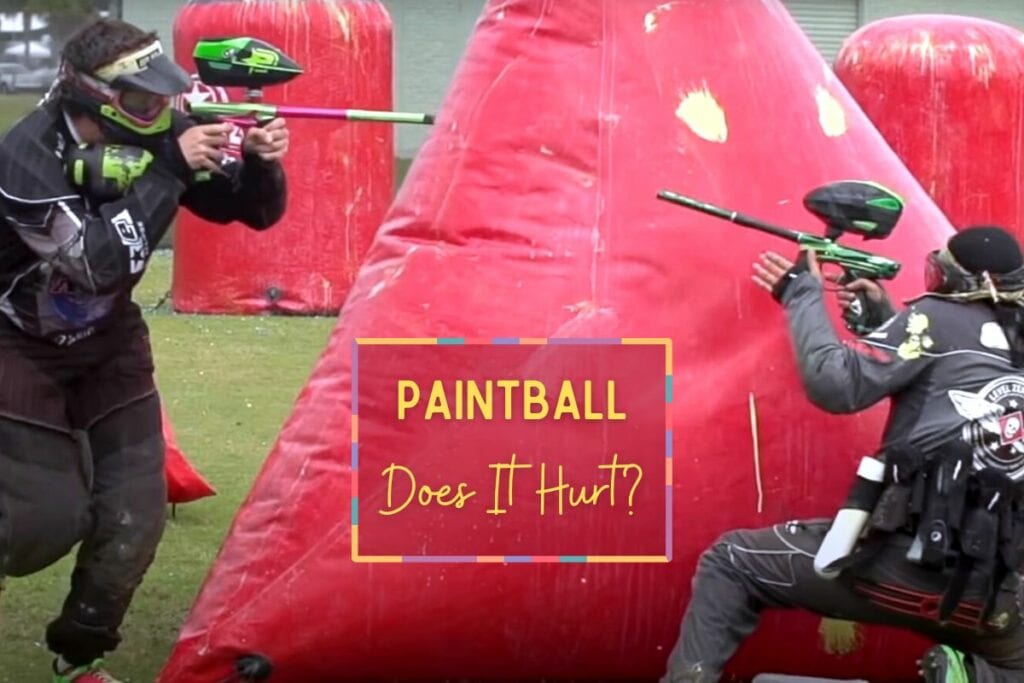
Does Paintball Hurt? How Much?
OUCH! Paintball can hurt you, and the sensation is akin to a sharp snap from a rubber band or getting stung by a bee. As those pellets travel through the air at a speed of around 300 FPS, you’ll likely feel a stinging sensation. The pain is usually mild and goes away quickly, but at times, it can be quite intense and might even leave a noticeable mark on bare skin. The duration of this discomfort can range from a few seconds to minutes, depending on the force of the impact.
But here’s the twist: the pinch isn’t the same for everyone. The threshold of pain can fluctuate based on a number of factors, including the distance between you and the shooter, the paint ball’s velocity, and the safety gear you’ve used. Typically, players suit up in protective clothing and equipment to cushion the blow and keep the risk of injury at bay.
Here is a video showing how much paintballs hurt with no protective clothing. Never try this on your own, and always wear protective gear when playing the game.
Factors That Determine How Much Will Paintballs Hurt
- Distance Between Shooter And Target: It is one of the most significant factors that affect the level of pain caused by a paintball hit. The farther away the shooter is, the less velocity and impact the ball will have, resulting in less pain. However, at close range, it can hurt you due to the high speed and force of impact.
- Velocity Of Paintballs: The speed at which the paintball travels is another crucial factor that determines the level of discomfort. The velocity can range from 200 to 300 feet per second (FPS), and higher velocity results in more pain. In some cases, markers can shoot at speeds over 300 FPS, which can be incredibly painful and potentially dangerous. Most fields and arenas set limits on the maximum velocity allowed for safety reasons.
- Size Of Paint balls: The size of the paint ball can also affect how hard they will impact. Standard pellets have a diameter of .68 inches, but some guns can shoot smaller or larger balls. Smaller balls may cause less pain, while larger balls may cause more pain due to their increased surface area.
- Location Where Paintballs Hit: The location where the ball hits the body can greatly affect the pain level. Areas with less muscle and fatty tissue tend to be more painful, while areas with more cushioning tend to be less painful. For example, a hit on the hand or finger can be incredibly painful due to the lack of protective tissue, while a hit on the thigh or buttocks may hurt less due to the more substantial muscle tissue.
- Protective Clothing: The thickness and type of clothing worn can also impact how hard paintballs will be. Thick, layered clothing can absorb some of the impact and reduce the level of pain. For example, wearing long-sleeved shirts, pants, and gloves can provide some protection from the impact of the bullets.
- Safety Gear: The use of protective gear, such as goggles, face masks, and chest protectors, can greatly reduce the level of pain and injury. They protect the sensitive areas around the eyes, nose, and mouth, while chest protectors offer additional protection to the torso and vital organs.
- Pain Tolerance: Pain tolerance levels vary from person to person, with some individuals being more sensitive than others. Additionally, the adrenaline rush during paintball games can often mask the pain to some extent, so some players may not feel as much hurt as others.
Also Read: How To Prevent Fogging On A Paintball Mask?
Does Getting Hit With Paintballs Cause Bruises?
Feeling the sting, huh? Well, let me tell you, taking a hit from a paintball isn’t exactly a spa day experience. It can leave bruises, and not the kind you want to show off, particularly if it hits the skin at close range or with high velocity. When a ball hits the skin from a close range, it may create a sudden pressure that can cause the blood vessels to rupture, leading to bruising. This can be quite hurtful.
The severity of the bruising depends on various factors, such as the force and speed of the pellet, the distance from which it was fired, and the area of the body it hit. For instance, a paint ball hit on the arms, legs, or back may cause less severe bruising compared to hits on the thighs or torso, which tend to have more soft tissue.
But here’s the secret: GEAR UP, my friend! Thick clothing and padding can turn those bruising hits into mere love taps, and a facemask is your guardian angel for those sensitive spots around your eyes, nose, and mouth.
Now, you might be wondering, have I been there, done that? Absolutely! Paintballs have left their mark on me a few times, but thanks to following safety guidelines and being geared up, I’ve come away without a single bruise.
And if, by chance, you do end up with bruising, don’t sweat it. Just take a break from the battlefield until you’re all healed up – no sense in turning those battle scars into something more serious!
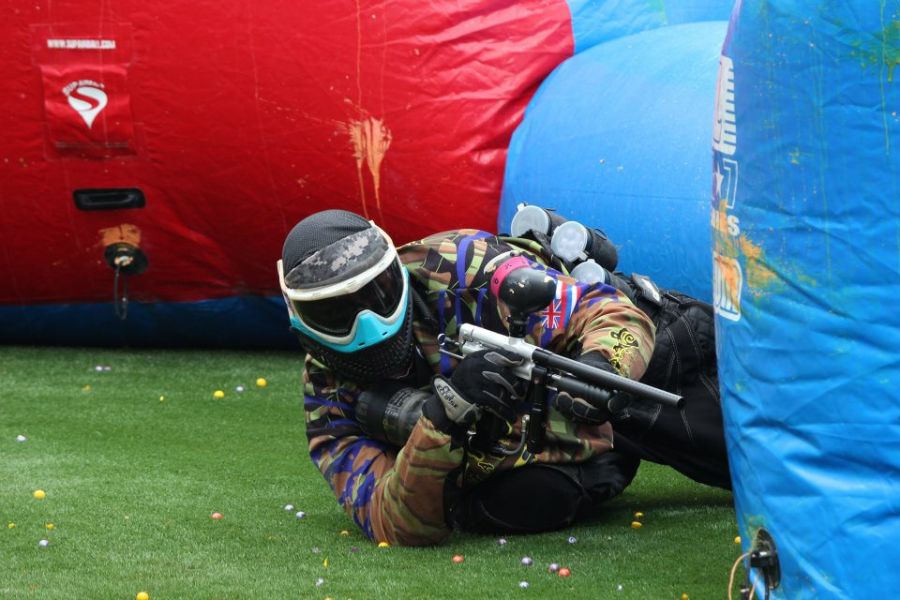
Where Do Paint Balls Hurt The Most?
While different people may have different pain tolerances, there are certain areas of the body where paintballs tend to hurt more. So, which areas tend to ring the pain alarm the loudest? Well, in my experience, the most sensitive areas are typically those with less muscle or fatty tissue to absorb the impact of the ball. For instance, hits on the hands, fingers, neck, inner thighs, groin, and feet can be particularly painful, as these areas have less cushioning.
Additionally, paintball hits on bony areas such as the shins, knees, and elbows can be uncomfortable, as the impact can create a sharp, stinging sensation. Hits to the back, chest, or stomach can also be painful, particularly if the player is hit at close range or with high velocity.
If you use a mask or helmet that does not enclose the face completely, a strike on the cheeks, nose, or ears can be painful. Thus, you need a paintball mask that completely covers the face and head, so that you may get hit by a ‘mug shot’ by not hurt. Similarly, you need to wear gloves to avoid getting hit on the fingers.
Likewise, if you wear a chest guard, a hit to the chest will not cause pain. With the additional padding, the impact of the paintball is less painful and more like a thud or a sting. So, gear up, soldier, and pain won’t stand a chance!
Is There Any Paintball That Does Not Cause Pain?
Low-impact paintball and splatmaster (.43 or .5 caliber) cause far less pain than traditional .68 caliber paintball. Those games provide the ideal opportunity to avoid the pain, making them suitable even for kids.
In a low-impact paintball, you might not even notice when you’ve been tagged. Why? Because these little paint balls are smaller, lighter, and cruise at lower speeds. It’s like they’re in a ‘gentle’ setting. The kinetic energy they bring is about one-third of the traditional paintball, which means they give your skin a much softer impact.
As a result, there is a lower likelihood of becoming wounded or bruised by the ball’s impact. But here’s the deal – even in low-impact games, it’s wise to keep your body well covered. When I played, low-impact paintball caused little to no discomfort as I always kept my body well covered to avoid stinging feelings.
Besides, in most arenas, kids above 6 years can play pee wee paintball- another option that does not cause pain. There are even paintless paintball or reball, known to cause much less discomfort or pain.
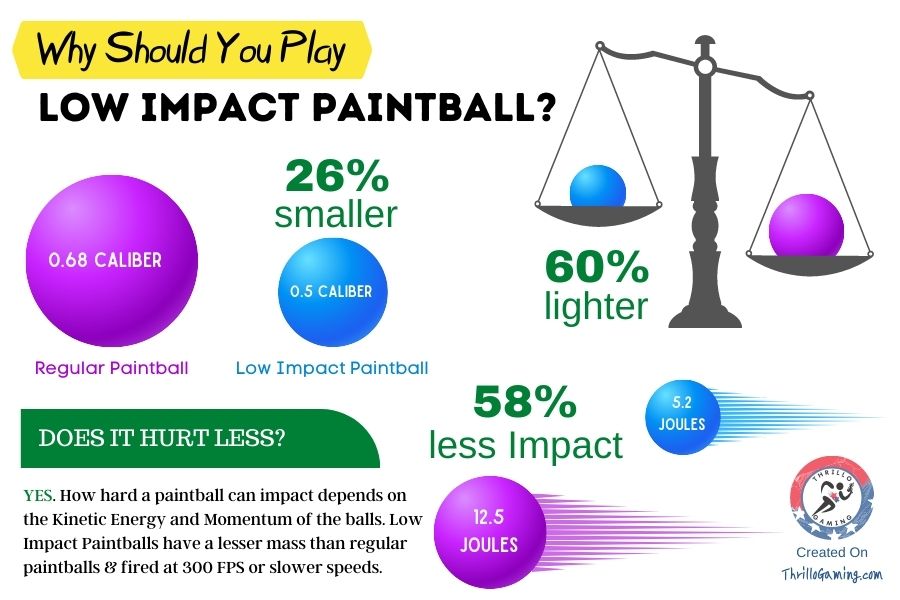
Do Paintballs Hurt More Than Airsoft Or BB Pellets?
The ‘ow’ level you experience when you get hit by a bullet from toy guns like paintball, airsoft, BB, and Orbeez is all about science – specifically, the kinetic energy, a factor of the mass of the ammo and its velocity. To give you the lowdown, here’s a handy comparison chart showcasing the average weight, speed, and kinetic energy of these pellets.
| Pellet | Avg. Weight | Avg. Speed | Avg. Kinetic Energy |
|---|---|---|---|
| Paintball | 3 grams | 300 FPS | 12.5 Joules |
| Airsoft | 0.2 grams | 400 FPS | 1.48 Joules |
| BB | 0.35 grams | 200 FPS | 0.65 Joules |
Since paintball pellets are heavier, bigger, and have a higher velocity, they can hurt more than BB or airsoft pellets. This means that a paint ball’s impact can be more severe if you don’t wear safety gear, and it can result in a bruise or stinging feeling when it impacts the skin.
Airsoft, on the other hand, uses smaller and lighter plastic pellets, although they can be fired at a higher velocity. While they can still deliver a sting or a bruise, it’s generally less painful compared to paintball.
Now, BB guns, they’re in a different league. These little metal pellets fly slower than paintballs or airsoft pellets, resulting in less powerful impacts. This means they’re less likely to cause serious discomfort or injury, but don’t take that as an invitation to skip protections.
In my experience, wearing proper gear, taking safety precautions, and not compromising on them can never hurt you badly in paintball.
Related: Paintball Vs Airsoft Comparison
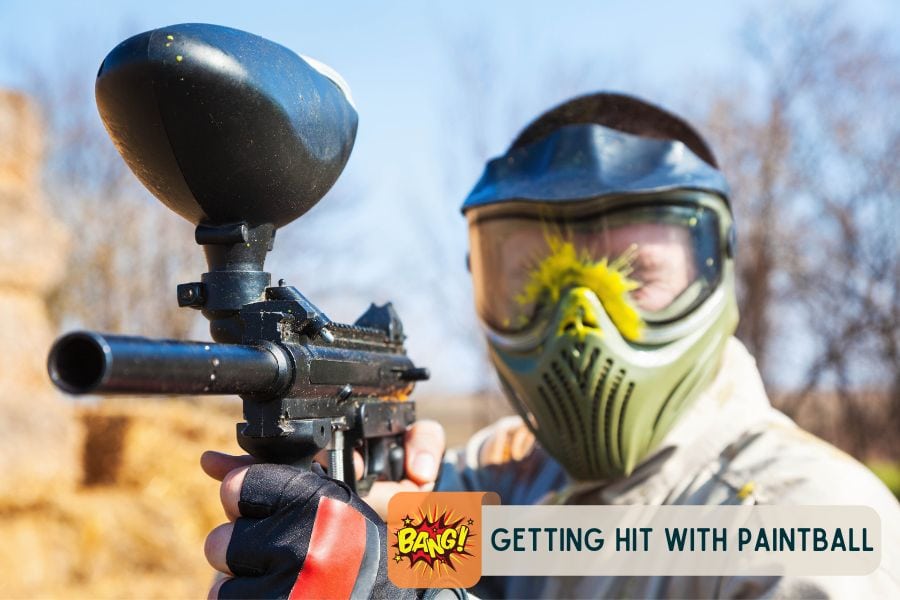
What To Do If You Get Hurt With Paintballs?
If you get hit with a paintball, first of all, DO NOT PANIC. After all, the primary goal of paintball is to have fun. But, if the marked area gets painful, you must take several actions. Here is step-by-step guide:
- Call The Referee: When you get hurt, immediately call out to a nearby referee to indicate that you are out of the round. He will then check the hit and confirm whether you are out or not.
- Check Yourself: After calling for a referee, check yourself for any signs of injury. Look for any marks, bruises, or welts that may have been caused by the paintball hit. If you notice any serious injuries or excessive bleeding, seek medical attention immediately.
- Stay Calm: Getting hit with a paint ball can be shocking and painful, but it’s important to stay calm and composed. Don’t lash out in anger or frustration, as this could result in further injury or disciplinary action.
- Leave the Field: Once you’ve been confirmed out, leave the playing field immediately to avoid interfering with the ongoing game. Head to the designated safe zone to wait for the end of the round or until you are ready to play again.
- Clean Yourself Up: After the match, clean yourself up by wiping off any paint residue with a damp towel or rag. Be sure to wash the affected area thoroughly with soap and water to prevent infection.
- Take Care of Bruises or Injuries: If you have any bruises or injuries caused by the paintball impact, take appropriate measures to care for them. Apply ice to the affected area to reduce swelling and pain, and consider taking over-the-counter pain medication if needed. I know it hurts, so keep patience.
- Reflect and Learn: Finally, take some time to reflect on your experience and learn from it. Consider what you could have done differently to avoid getting hit, and make adjustments to your strategy for the next game. Remember that paintball is a fun and challenging sport, and every hit is an opportunity to learn and grow as a player.
You May Also Like: How Long Do Paintballs Last In Good Shape?
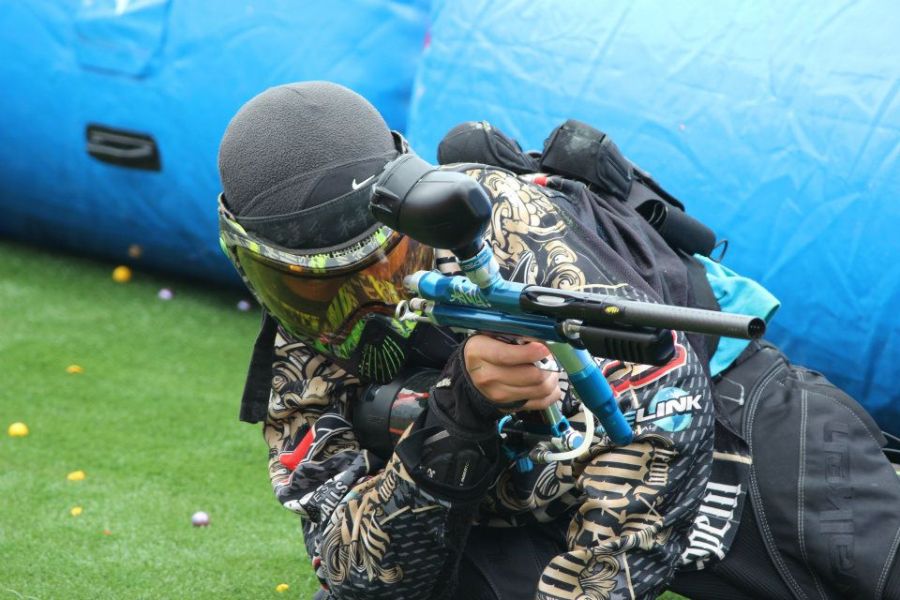
Paintball Safety Guidelines: Tips To Avoid Getting Hurt
As promised, this article will provide you with tips and guidelines on how to safely play paintball without causing harm to yourself or others. Let’s dive into some practical advice that will allow you to have a blast while playing paintball while also maintaining a safe and secure environment.
Must Wear Protective Gear
Protective gear is essential for preventing injuries while playing. Make sure your gear fits properly and is in good condition. Your mask should be impact-resistant and cover your entire face. Chest protectors, gloves, and elbow and knee pads can also help protect against injuries. As I experienced, this is the most crucial point to stay safe and avoid getting hurt in a paintball fight.
Understand Game Rules and Safety Guidelines
Knowing the game rules and safety regulations is crucial for staying safe while paintballing. Listen carefully to the referee’s instructions and follow them closely. Familiarize yourself with the boundaries of the playing field and any designated safe zones. If you’re unsure about a rule or guideline, ask for clarification.
Use Proper Equipment
Using high-quality, properly functioning paintball guns and equipment is important for preventing injuries. Keep your gun on safety mode when not in use and never point it at anyone unless you intend to shoot. Make sure your gun is properly cleaned and maintained.
Be Mindful of Your Surroundings
Being aware of your surroundings can help you avoid collisions with other players and obstacles. Watch out for other players, obstacles, or potential hazards on the field. Avoid running into objects or tripping over uneven terrain.
Communicate with Your Teammates
Effective communication with your teammates is crucial for a safe and successful paintball match. Develop a game plan with your teammates before starting, and use hand signals or verbal cues during play to communicate with each other. Make sure everyone on your team is aware of the plan and knows their role to avoid getting hurt in the match.
Don’t Overshoot
Overshooting other players can cause unnecessary pain and injury. Two or three shots are typically enough to eliminate a player. Aiming and shooting someone who is already out of the round or who has signaled that they are surrendering is also considered poor sportsmanship.
Know Your Limits
Don’t push yourself beyond your physical or mental limits while playing with paint balls. Take breaks if you need to, and stay hydrated. If you feel tired or lightheaded, take a rest before continuing to play.
Respect Other Players
Treat other players with respect and courtesy in the field. Avoid shooting at players who are already out of the game or who have signaled that they are surrendering. Be mindful of your aim and try to avoid shooting players in sensitive areas such as the head or groin.
Choose Your Playing Field Carefully
Before playing, research and choose a reputable paintball field that is well-maintained and safe. Avoid fields with hazards such as sharp objects, holes, or unstable terrain. Make sure the field has proper safety measures in place, such as netting or barriers.
Warm Up Before Playing
Taking some time to warm up your body with stretching exercises before playing can help prevent muscle strains and other injuries. Start with some light cardio to get your heart rate up, then do some stretching exercises to loosen up your muscles. Focus on stretching your arms, legs, and back to avoid getting hurt in paintball.
Apart from the above tips, watch this informative video for more help:
It’s important to remember that paintball is a sport, and getting hit by a ball is a part of the game. However, by taking the appropriate steps to minimize pain and discomfort, you can continue to enjoy paintball and win it without worrying about injury.
Finally, it’s critical to know where the closest emergency services are located and to have a first aid package on hand in case of serious injury. You can also check the paintball alternatives if you are too worried about the ‘pain factor’.


Very informative guide on the safety considerations. Now I feel more confident to play paintball. Thanks for sharing!